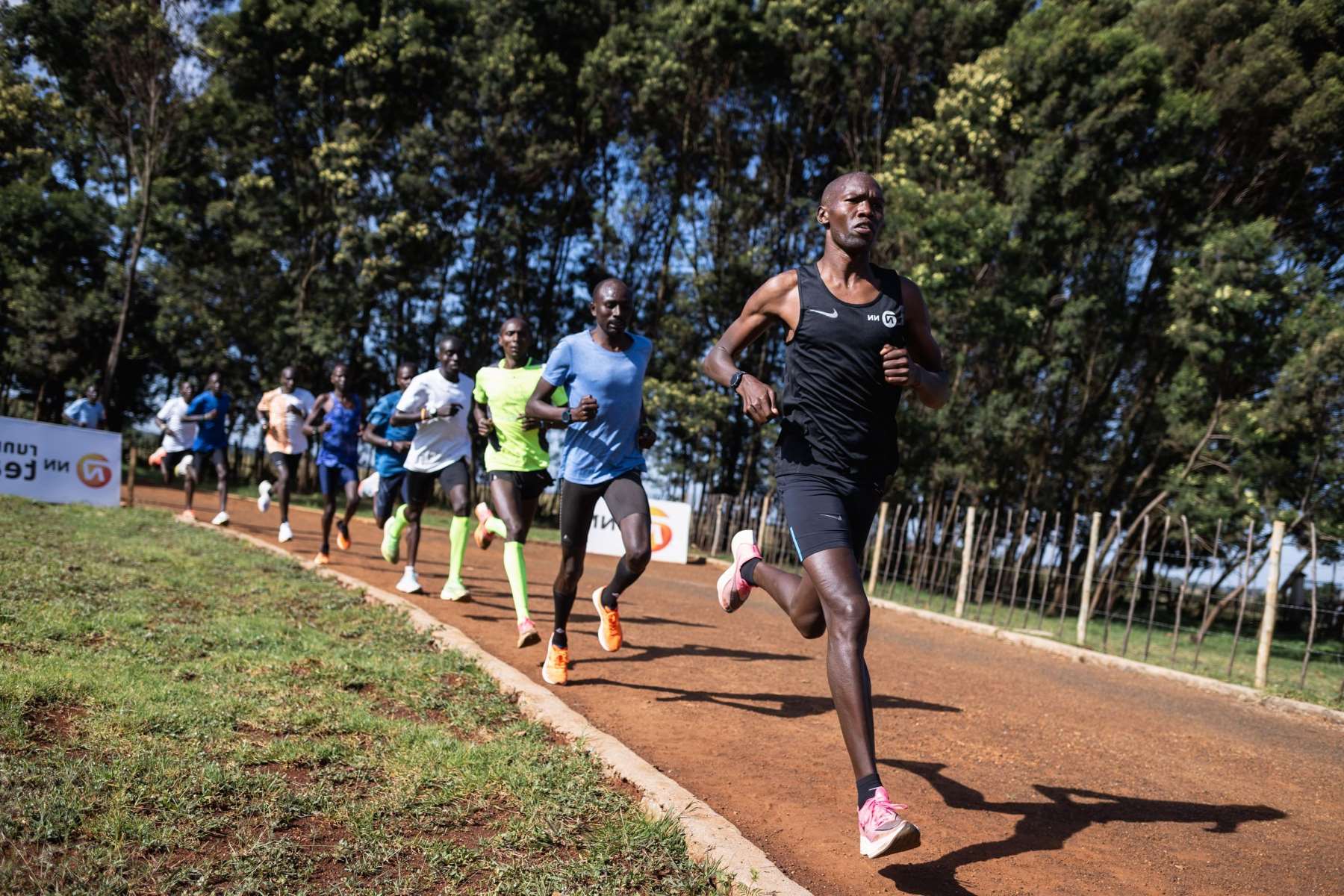Home>Training & Techniques>Double The Distance: A Guide To Increasing Your Running Mileage


Training & Techniques
Double The Distance: A Guide To Increasing Your Running Mileage
Published: March 1, 2024
"Learn effective training and techniques to double your running mileage with our comprehensive guide. Achieve your distance goals and improve your running performance."
(Many of the links in this article redirect to a specific reviewed product. Your purchase of these products through affiliate links helps to generate commission for Therunningadvisor.com, at no extra cost. Learn more)
Table of Contents
Setting Your Mileage Goals
Setting realistic and achievable mileage goals is the first step in increasing your running distance. Whether you're a beginner aiming to complete your first 5K or an experienced runner striving for a marathon, establishing clear objectives is crucial for progress. Here's how to set effective mileage goals:
-
Assess Your Current Fitness Level: Before determining your mileage goals, it's essential to evaluate your current fitness level. Consider the distance you can comfortably run without feeling overly fatigued. This baseline will serve as a starting point for setting realistic targets.
-
Consider Your Long-Term Aspirations: Reflect on your ultimate running aspirations. Do you aim to complete a half marathon, marathon, or ultra-marathon? Understanding your long-term objectives will help you establish incremental milestones that align with your overarching goals.
-
Embrace Incremental Progress: It's important to embrace incremental progress when setting mileage goals. Instead of aiming to double your distance overnight, focus on gradual increases. For instance, if your current comfortable distance is 3 miles, aim to add 0.5-1 mile to your runs every 1-2 weeks.
-
Factor in Recovery and Adaptation: When setting mileage goals, consider the importance of recovery and adaptation. Your body needs time to adjust to increased distances, so be mindful of incorporating rest days into your training schedule to prevent overexertion and minimize the risk of injury.
-
Account for Time and Commitment: Assess your schedule and commit to a realistic training routine. Setting mileage goals that align with your available time and commitment will enhance your chances of success while reducing the likelihood of burnout or frustration.
By setting specific, measurable, achievable, relevant, and time-bound (SMART) mileage goals, you can effectively track your progress and stay motivated throughout your running journey. Remember, the key is to challenge yourself while maintaining a healthy balance to prevent overexertion and burnout.
Building Endurance and Stamina
Building endurance and stamina is essential for increasing your running mileage. It involves gradually conditioning your body to handle longer distances and sustained physical exertion. By implementing targeted training techniques and incorporating strategic adjustments to your running routine, you can effectively enhance your endurance and stamina. Here's how to build endurance and stamina for long-distance running:
-
Consistent Training: Consistency is key when it comes to building endurance and stamina. Regular, structured training sessions allow your body to adapt to the demands of long-distance running. Aim to establish a weekly training schedule that includes a mix of short, medium, and long runs to progressively challenge your endurance.
-
Long Runs: Incorporating weekly long runs into your training regimen is crucial for developing endurance. Gradually increase the distance of your long runs, aiming to extend your mileage by 10-20% each week. These extended sessions condition your body to sustain prolonged physical activity and help build mental resilience for longer distances.
-
Cross-Training: Engaging in cross-training activities such as cycling, swimming, or strength training can complement your running routine and improve overall endurance. Cross-training helps prevent overuse injuries, strengthens supporting muscles, and enhances cardiovascular fitness, contributing to improved stamina during runs.
-
Hill Training: Integrate hill workouts into your training plan to boost endurance and stamina. Running uphill challenges your cardiovascular system and strengthens leg muscles, translating to enhanced performance on flat terrain. Additionally, downhill running can improve leg turnover and overall running economy.
-
Pace Variation: Incorporating pace variation in your runs can help improve endurance and stamina. Implementing tempo runs, where you sustain a comfortably hard pace for an extended period, and interval training, involving alternating between high-intensity bursts and recovery periods, can enhance your cardiovascular capacity and overall endurance.
-
Proper Recovery: Adequate rest and recovery are integral components of building endurance and stamina. Ensure that you allow for sufficient rest between challenging workouts to facilitate muscle repair and adaptation. Overtraining can lead to fatigue and decreased performance, so listen to your body and prioritize recovery.
By diligently implementing these strategies and gradually increasing the intensity and duration of your training, you can effectively build endurance and stamina, enabling you to conquer longer distances with confidence and resilience. Remember, consistency, patience, and a balanced approach are key to achieving sustainable improvements in endurance and stamina for long-distance running.
Incorporating Interval Training
Interval training is a highly effective method for enhancing running performance and increasing overall endurance. This structured approach involves alternating between intense bursts of exertion and periods of active recovery, allowing runners to push their limits and improve cardiovascular capacity. By incorporating interval training into your running routine, you can experience significant physiological adaptations that contribute to enhanced speed, endurance, and overall fitness.
Benefits of Interval Training
Interval training offers a myriad of benefits that directly translate to improved running performance. The structured nature of interval workouts allows runners to target specific energy systems, leading to physiological adaptations that contribute to enhanced endurance and speed. Some key benefits of incorporating interval training into your running regimen include:
- Improved Cardiovascular Fitness: Intense intervals elevate heart rate and challenge the cardiovascular system, leading to improved heart and lung function over time.
- Enhanced Speed and Power: Interval training helps improve running speed and power output by engaging fast-twitch muscle fibers and improving neuromuscular coordination.
- Increased Caloric Expenditure: The high-intensity nature of interval workouts can lead to greater post-exercise oxygen consumption (EPOC), resulting in continued calorie burn after the workout.
- Time-Efficient Workouts: Interval training allows runners to achieve significant physiological adaptations in a shorter amount of time compared to steady-state training, making it an efficient option for busy individuals.
Implementing Interval Workouts
When incorporating interval training into your running routine, it's essential to structure your workouts strategically to maximize the benefits while minimizing the risk of overexertion and injury. Here are key considerations for implementing interval workouts:
-
Selecting Appropriate Intervals: Choose interval lengths and intensities based on your current fitness level and running goals. Shorter, high-intensity intervals (e.g., 200-400 meters) target speed and anaerobic capacity, while longer intervals (e.g., 800-1600 meters) focus on aerobic endurance.
-
Balancing Work and Recovery: The ratio of work to recovery intervals is crucial for optimizing training adaptations. For example, a common approach is to implement a 1:1 work-to-recovery ratio for high-intensity intervals, allowing for adequate recovery between efforts.
-
Gradual Progression: Start with a manageable volume and intensity of intervals, then gradually increase the challenge as your fitness improves. This approach minimizes the risk of overtraining and allows for sustainable progress over time.
-
Incorporating Variety: Introduce a variety of interval workouts, including short sprints, tempo intervals, and hill repeats, to target different energy systems and prevent monotony in training.
By incorporating interval training into your running routine in a structured and progressive manner, you can harness its potent physiological benefits to elevate your running performance and conquer longer distances with confidence and speed. Remember to tailor your interval workouts to align with your current fitness level and long-term running aspirations, and always prioritize proper warm-ups and cooldowns to optimize the effectiveness of your interval training sessions.
Read more: What Is Your Running Distance Limit?
Proper Nutrition for Increased Mileage
Proper nutrition plays a pivotal role in supporting increased mileage and overall running performance. As you strive to conquer longer distances and push your physical limits, fueling your body with the right nutrients becomes paramount for sustaining energy levels, promoting recovery, and optimizing endurance. Here's a comprehensive guide to understanding and implementing proper nutrition for increased mileage:
Balancing Macronutrients
Achieving a balanced intake of macronutrients – carbohydrates, proteins, and fats – is essential for supporting the increased energy demands of long-distance running. Carbohydrates serve as the primary fuel source for endurance activities, making up a significant portion of a runner's diet. Incorporating complex carbohydrates such as whole grains, fruits, and vegetables provides sustained energy for prolonged runs. Additionally, adequate protein intake supports muscle repair and recovery, while healthy fats contribute to overall energy reserves and essential fatty acid absorption.
Pre-Run Fueling
Prior to longer runs, it's crucial to consume a balanced meal or snack that provides readily available energy without causing digestive discomfort. Opt for easily digestible carbohydrates, such as a banana with nut butter or a small bowl of oatmeal, to fuel your body before hitting the road. Timing is key – aim to consume your pre-run meal or snack approximately 1-2 hours before your run to allow for proper digestion and utilization of nutrients.
Hydration Strategies
Proper hydration is fundamental for maintaining performance and preventing dehydration during extended runs. In the hours leading up to your run, focus on adequate fluid intake to ensure optimal hydration status. During longer runs, consider carrying a hydration pack or planning your route to include water stations to replenish fluids as needed. Electrolyte-rich beverages or gels can also support hydration and replenish essential minerals lost through sweat during prolonged exercise.
Post-Run Recovery
After completing a long run, prioritizing post-run nutrition is vital for facilitating muscle recovery and replenishing energy stores. Consuming a combination of carbohydrates and protein within 30-60 minutes post-exercise supports glycogen replenishment and muscle repair. Options such as a protein smoothie with added fruits, a turkey and avocado sandwich on whole-grain bread, or a balanced meal containing lean protein and complex carbohydrates can aid in recovery and prepare your body for subsequent training sessions.
Long-Term Nutritional Planning
As you progressively increase your running mileage, it's important to consider long-term nutritional planning to support sustained performance and overall well-being. Working with a registered dietitian or sports nutritionist can provide personalized guidance on optimizing your dietary intake to align with your training goals and individual nutritional needs. Additionally, incorporating nutrient-dense foods, such as leafy greens, lean proteins, and healthy fats, into your daily meals fosters overall health and supports the demands of increased mileage.
By prioritizing proper nutrition and adopting a holistic approach to fueling your body for increased mileage, you can optimize your running performance, enhance endurance, and promote overall well-being. Remember, individual nutritional needs may vary, so it's essential to listen to your body, experiment with different fueling strategies, and seek professional guidance to tailor your nutrition plan to support your running journey effectively.
Avoiding Overuse Injuries
Overuse injuries are a common concern for runners, especially when increasing mileage. These injuries result from repetitive stress on the muscles, tendons, and bones without adequate time for recovery, leading to tissue breakdown and inflammation. To safeguard against overuse injuries and sustain long-term running success, it's crucial to implement proactive measures and prioritize injury prevention. Here's a comprehensive guide to avoiding overuse injuries:
Gradual Mileage Progression
Gradual mileage progression is paramount for injury prevention. Abruptly increasing running volume significantly raises the risk of overuse injuries, such as stress fractures, tendinitis, and muscle strains. Aim to increase weekly mileage by no more than 10% to allow your body to adapt gradually and minimize the likelihood of overuse-related issues.
Proper Footwear and Equipment
Investing in appropriate running shoes that suit your foot type and running gait can significantly reduce the risk of overuse injuries. Quality footwear provides adequate cushioning, stability, and support, effectively absorbing impact forces and minimizing stress on the lower extremities. Additionally, ensuring that running gear, such as compression sleeves or supportive braces, is well-maintained and properly fitted can aid in injury prevention.
Cross-Training and Strength Work
Incorporating cross-training activities, such as swimming, cycling, or yoga, into your routine can help mitigate the risk of overuse injuries by providing variety in movement patterns and reducing repetitive strain on specific muscle groups. Furthermore, integrating strength training exercises that target key running muscles, including the core, hips, and lower body, can enhance muscular balance and stability, reducing the likelihood of overuse-related imbalances and injuries.
Listen to Your Body
Attentively listening to your body's signals is crucial for injury prevention. Persistent pain, discomfort, or unusual fatigue should not be ignored, as they may indicate underlying issues that require attention. Being attuned to subtle changes in your running mechanics, such as altered gait or asymmetrical movement patterns, can prompt early intervention and prevent the escalation of potential overuse injuries.
Adequate Rest and Recovery
Prioritizing rest and recovery is essential for preventing overuse injuries. Incorporating rest days into your training schedule allows for tissue repair and adaptation, reducing the cumulative stress on your body. Additionally, implementing active recovery strategies, such as foam rolling, stretching, and massage, can alleviate muscle tension and enhance overall recovery, minimizing the risk of overuse-related discomfort and injuries.
By conscientiously integrating these proactive measures into your running routine, you can effectively mitigate the risk of overuse injuries and sustain long-term running enjoyment and success. Remember, injury prevention is a holistic endeavor that encompasses gradual progression, attentive self-care, and a balanced approach to training, ultimately safeguarding your running journey against the perils of overuse-related setbacks.
Mental Strategies for Pushing Through Longer Runs
When it comes to conquering longer runs, mental fortitude plays a pivotal role alongside physical preparedness. Endurance challenges, such as tackling extended distances or pushing through fatigue, often necessitate the application of effective mental strategies to maintain motivation, manage discomfort, and sustain performance. Here are insightful mental strategies to empower your mindset and propel you through the demands of longer runs:
Goal Setting and Visualization
Setting clear, attainable goals and visualizing success can significantly bolster mental resilience during longer runs. Establishing specific milestones, such as reaching a certain distance marker or maintaining a consistent pace, provides tangible targets to focus on, fostering a sense of achievement and progress. Visualization techniques, where you vividly imagine yourself overcoming challenges and crossing the finish line, can instill confidence and determination, serving as a powerful mental tool to navigate the rigors of extended running endeavors.
Positive Self-Talk and Affirmations
Harnessing the power of positive self-talk and affirmations can uplift your spirits and bolster mental strength during prolonged runs. Cultivate a repertoire of encouraging phrases and affirmations, such as "I am strong," "I can overcome any obstacle," and "I am capable of pushing through," to counter negative thoughts and self-doubt. By consciously directing your inner dialogue towards optimism and self-belief, you can cultivate a resilient mindset that propels you forward, even when faced with physical and mental fatigue.
Mindfulness and Present-Moment Focus
Practicing mindfulness and honing your ability to stay present in the moment can be transformative for enduring longer runs. By directing your attention to the sensations of your breath, the rhythm of your strides, and the surrounding environment, you can anchor yourself in the present, fostering a sense of calm and focus. Embracing mindfulness techniques, such as deep breathing and body scans, can help alleviate mental distractions and anxieties, allowing you to navigate the challenges of longer runs with a centered and composed mindset.
Mantras and Mental Distractions
Employing personalized mantras and mental distractions can serve as effective coping mechanisms during arduous runs. Whether it's repeating a motivating phrase, focusing on the rhythm of your footfalls, or engaging in mental games and visualizations, these tactics can divert attention from discomfort and fatigue, providing a mental respite and injecting renewed vigor into your running performance. By integrating these mental diversions, you can navigate the mental hurdles of longer runs with enhanced resilience and determination.
Embracing Discomfort and Resilience
Embracing discomfort as a natural part of the running experience and cultivating resilience in the face of adversity are fundamental mental strategies for enduring longer runs. Acknowledge that discomfort is temporary and that you possess the inner strength to persevere through challenging moments. By reframing discomfort as an opportunity for growth and resilience, you can cultivate a tenacious mindset that empowers you to push through barriers and emerge stronger on the other side.
Incorporating these mental strategies into your running arsenal can elevate your capacity to conquer longer distances with confidence and determination. By nurturing a resilient and focused mindset, you can transcend the mental barriers that accompany extended runs, unlocking your full potential as a long-distance runner. Remember, your mental fortitude is a powerful ally that can propel you through the most demanding stretches of your running journey, ultimately leading to personal triumph and fulfillment on the road.
Gradually Increasing Mileage
Gradually increasing mileage is a fundamental principle in long-distance running that underpins sustainable progress and injury prevention. This strategic approach involves methodically expanding the distance of your runs over time, allowing your body to adapt to the escalating demands of endurance training. By adhering to a gradual mileage progression, runners can optimize their physiological adaptations, minimize the risk of overuse injuries, and foster long-term enjoyment and success in their running endeavors.
The essence of gradual mileage progression lies in its emphasis on patience, consistency, and respect for the body's capacity to adapt. Rather than succumbing to the temptation of rapid mileage escalation, which can lead to overtraining and heightened injury susceptibility, runners who embrace gradual progression prioritize the incremental expansion of their running volume. This approach allows for the gradual strengthening of muscles, tendons, and cardiovascular systems, facilitating a sustainable increase in endurance and resilience.
A key aspect of gradually increasing mileage is the principle of respecting the body's adaptation timeline. As runners incrementally extend their distances, they afford their bodies the necessary time to acclimate to the heightened physical demands. This deliberate pacing enables physiological adjustments, such as enhanced capillary development, improved muscular endurance, and optimized energy utilization, all of which contribute to improved performance and reduced injury risk.
Moreover, gradual mileage progression aligns with the concept of periodization, a structured training approach that involves systematically varying training volume and intensity to optimize performance and recovery. By integrating periods of gradual mileage increase with strategic recovery phases, runners can achieve sustainable progress while mitigating the cumulative stress on their bodies. This balanced approach fosters a harmonious adaptation process, allowing for the consolidation of training gains and the preservation of overall well-being.
In essence, the art of gradually increasing mileage embodies the ethos of sustainable growth and prudent training management. By embracing this principle, runners can cultivate a resilient and enduring foundation, laying the groundwork for long-term running success and fulfillment. Through the patient and deliberate expansion of running distances, individuals can unlock their full potential, conquer new milestones, and embark on a journey of continuous improvement and personal triumph on the roads and trails.
The Importance of Rest and Recovery
Rest and recovery are integral components of a well-rounded training regimen, playing a pivotal role in optimizing performance, preventing injuries, and sustaining long-term running enjoyment. In the pursuit of increased mileage and enhanced endurance, the significance of prioritizing adequate rest and recovery cannot be overstated. Here's an in-depth exploration of the critical role that rest and recovery play in the context of long-distance running.
Physiological Adaptation and Repair
Rest and recovery periods provide the body with essential opportunities for physiological adaptation and repair. During periods of rest, the body undergoes crucial processes such as muscle tissue repair, glycogen replenishment, and the restoration of hormonal balance. These physiological adaptations are fundamental for enhancing muscular strength, endurance, and overall performance. Additionally, adequate rest allows for the consolidation of training gains, enabling the body to adapt to the stress of increased mileage and progressively improve its capacity to handle longer distances.
Injury Prevention and Tissue Regeneration
Sufficient rest and recovery are instrumental in mitigating the risk of overuse injuries, which can derail training progress and lead to prolonged setbacks. Continuous physical exertion without adequate recovery can result in cumulative stress on muscles, tendons, and bones, increasing the susceptibility to injuries such as stress fractures, tendinitis, and muscle strains. By incorporating rest days into the training schedule and allowing for proper recovery between challenging workouts, runners can minimize the likelihood of overuse-related injuries and promote tissue regeneration, fostering a resilient musculoskeletal system capable of withstanding the demands of extended running endeavors.
Mental Rejuvenation and Motivation
In addition to its physiological benefits, rest and recovery play a crucial role in mental rejuvenation and sustaining motivation. Long-distance running can be mentally taxing, and the inclusion of rest days allows runners to recharge both physically and mentally. These periods of respite provide an opportunity to alleviate mental fatigue, rekindle enthusiasm for training, and maintain a positive mindset. By embracing rest and recovery as essential components of the training process, runners can cultivate a balanced and sustainable approach to their running journey, fostering long-term motivation and enjoyment.
Optimal Performance and Adaptation
Ultimately, the integration of adequate rest and recovery into a training regimen is essential for optimizing performance and facilitating adaptation to increased mileage. By strategically incorporating rest days and recovery periods, runners can achieve a delicate balance between training stimulus and recovery, allowing for the assimilation of training adaptations and the realization of performance gains. This balanced approach fosters sustainable progress, enabling runners to thrive in their pursuit of longer distances while minimizing the risk of burnout and overtraining.
In essence, the importance of rest and recovery in the context of long-distance running cannot be overstated. By recognizing the pivotal role that adequate rest and recovery play in optimizing performance, preventing injuries, and sustaining motivation, runners can cultivate a holistic and balanced approach to their training, ultimately fostering enduring success and fulfillment in their running endeavors.










